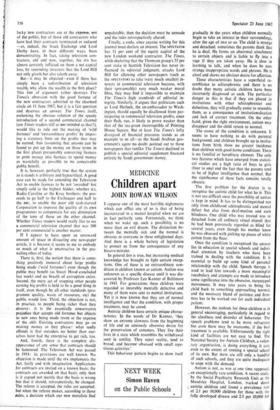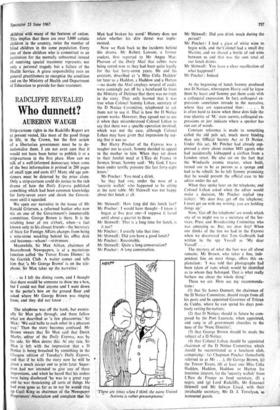Children apart
MEDICINE JOHN ROWAN WILSON
I suppose one of the most horrible nightmares which can afflict any of us is that of being incarcerated in a mental hospital when we are in fact perfectly sane. Fortunately, we think when we wake up, such a possibility is no more than an evil dream. The distinction be- tween the mentally sick and the normal is obvious to everyone in these enlightened days. And there is a whole battery of legislation to protect us from the consequences of any bizarre mistake.
In general this is true, but increasing medical knowledge has brought to light certain excep- tions. One of these is an extraordinary con- dition in children known as autism. Autism was unknown as a specific disease until it was dis- covered by Professor Leo Kanner of Baltimore in 1943. For generations these children were regarded as incurably mentally defective and many of them were sent to mental institutions. Yet it is now known that they are of normal intelligence and that the condition, with proper treatment, may be cured.
Autistic children have certain unique charac- teristics. In the words of Dr Kanner, 'they show an extreme slowness from the beginning of life and an anxiously obsessive desire for the preservation of sameness. They live their lives in a state which resembles the withdrawal seen in senility. They reject reality, tend to brood, and become obsessed with small repe- titious activities.'
This behaviour pattern begins to show itself gradually in the years when children normally begin to take an interest in their surroundings, after the age of two or so. The child is strange and detached; sometimes the parents think that he is deaf. He forms an abnormal attachment to certain objects and is liable to fly into a rage if they are taken away. He is slow in learning to talk, and when he does he uses strange inappropriate words and phrases. He is aloof and shows no obvious desire for affection.
These characteristics have a superficial re- semblance to schizophrenia and there is no doubt that many autistic children have been incorrectly diagnosed as such. The particular danger to this is that if they are placed in institutions with other schizophrenics and defectives, they will gradually come to resemble them, as a consequence of institutionalisation and lack of correct treatment. On the other hand, given the right environment, autism may disappear and the child return to normal.
The cause of the condition is unknown. It seems to have nothing to do with parental background, and children brought up in institu- tions from birth show no greater incidence than children with good home conditions. There is no familial or hereditary element. The only two features which have emerged from statisti- cal studies are a high ratio of boys to girls (four to one) and the fact that the parents tend to be of higher intelligence than normal. But the significance of these facts remains totally obscure.
The first problem for the doctor is to recognise the autistic child for what he is. This is not too difficult once the possibility of autism is kept in mind. It has to be distinguished not only from childhood schizophrenia and mental defect but also from deaf-mutism and even blindness. One child who was treated was so detached from all ordinary visual stimuli that he had been previously regarded as blind for several years, even though his mother knew he was obsessed with picking up pieces of white cotton from the floor.
Once the condition is recognised the answer lies in education in special schools and indivi- dual attention by teachers who have been trained in dealing with the condition. It is essential to build up some kind of personal relationship with the child. Speech therapy is used to lead him towards a more meaningful vocabulary and attempts are made to introduce some significance into the obsessive, stereotyped movements. It may take years to bring the child back to something approaching normal, and the necessary blend of patience and firm- ness has to be worked out for each individual patient.
However, the outlook for these children is in general encouraging, -particularly in regard to the aloofness and disorder of behaviour. The ,speech problems tend to be more refractory but even these may be overcome, if the best treatment is available. Unfortunately the right kind of facilities are not easy to find. The National Society for Autistic Children, a volun- tary organisation, is doing everything, it can, even to the extent of running a special school of its own. But there are still only a handful of such schools, and they are quite inadequate to cope with the demand.
Autism is not, as was at one time supposed, an exceptionally rare condition. A recent study, by the Social Psychiatry Research Unit at the Maudsley Hospital, London, tracked down autistic children and found a prevalence rate of 2.1 per 10,000 children for those with the fully developed disease and 2.5 per 10,000 for
children with many of the features of autism. This implies that there are over 3,000 autistic children in the country, twice the number of blind children in the same population. Every one of these children who is committed to an institution for the mentally subnormal instead of receiving special treatment represents not only a personal tragedy but a failure of the Health Service. A grave responsibility rests on general practitioners to recognise the condition and on the Ministry of Health and Department of Education to provide for their treatment.































 Previous page
Previous page